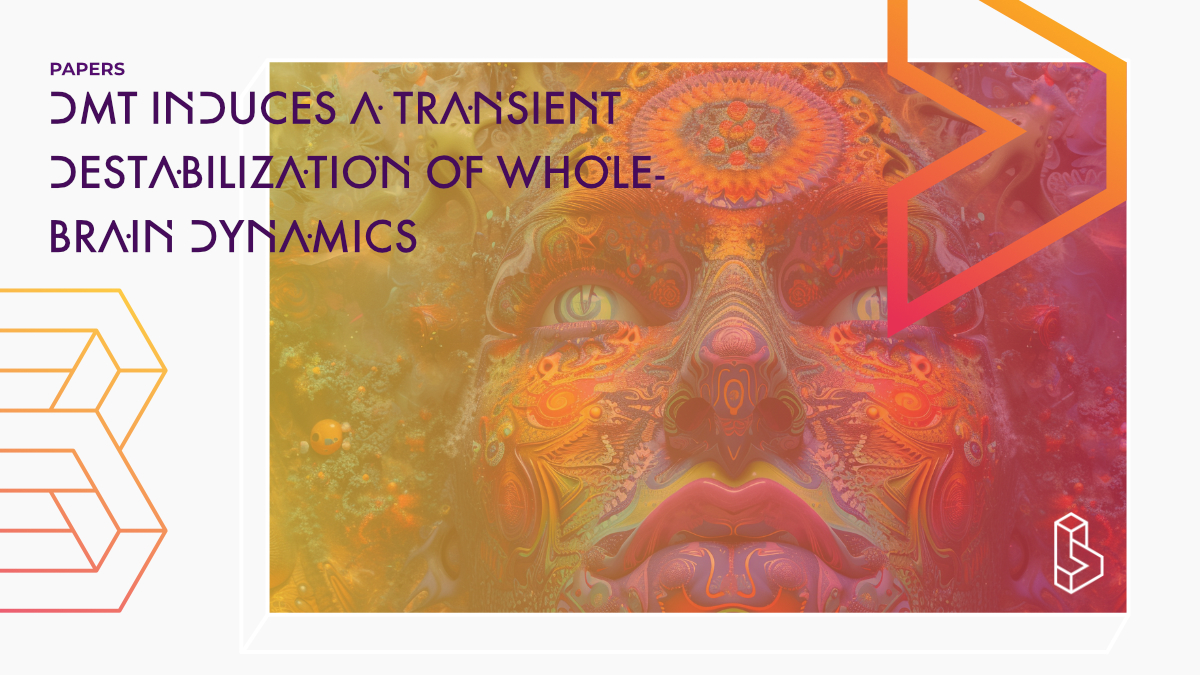This computational fMRI study (n=15; re-analysis of earlier data) examines brain dynamics after DMT (iv; 20mg) administration, focusing on the onset of the psychedelic state. It reveals a peak destabilization of brain dynamics around 5 minutes post-administration and identifies a heightened reactivity phase, primarily affecting fronto-parietal and visual regions. The study links these changes to serotonin 5HT2a receptor density, suggesting these dynamics underpin the psychedelic state’s complexity and flexibility.
Abstract of Transient destabilization of whole brain dynamics induced by DMT
“The transition towards the brain state induced by psychedelic drugs is frequently neglected in favor of a static description of their acute effects. We use a time-dependent whole-brain model to reproduce large-scale brain dynamics measured with fMRI from 15 volunteers under 20 mg intravenous N,N-Dimethyltryptamine (DMT), a short-acting psychedelic. To capture its transient effects, we parametrize the proximity to a global bifurcation using a pharmacokinetic equation. Simulated perturbations reveal a transient of heightened reactivity concentrated in fronto-parietal regions and visual cortices, correlated with serotonin 5HT2a receptor density, the primary target of psychedelics. These advances suggest a mechanism to explain key features of the psychedelic state and also predicts that the temporal evolution of these features aligns with pharmacokinetics. Our results contribute to understanding how psychedelics introduce a transient where minimal perturbations can achieve a maximal effect, shedding light on how short psychedelic episodes may extend an overarching influence over time.”
Authors: Juan I. Piccinini, Yonatan S. Perl, Carla Pallavicini, Gustavo Deco, Morten Kringelbach, David J. Nutt, Robin L. Carhart-Harris, Christopher Timmermann, & Enzo Tagliazucchi
Summary of Transient destabilization of whole brain dynamics induced by DMT
We previously covered this article as a pre-print in January 2024.
Psychedelic drugs increase global network integration measured with functional magnetic resonance imaging (fMRI), and evidence from multiple modalities links their effects to increased entropy and complexity of spontaneous brain activity fluctuations. Integrative understanding of psychedelic action requires identification of causal mechanisms behind empirical observations.
Generative whole-brain activity models have been increasingly adopted to test potential mechanisms underlying neuroimaging data, including successful applications to the specific case of psychedelic compounds psilocybin and LSD. The use of simpler models fitted to the empirical measurements can help shift the focus from the neurobiological details of drug action to the qualitative aspects of brain dynamics that characterize the acute effects of psychedelics.
Find this paper
Transient destabilization of whole brain dynamics induced by N,N-Dimethyltryptamine (DMT)
https://doi.org/10.1038/s42003-025-07576-0
Open Access | Google Scholar | Backup | 🕊
Cite this paper (APA)
Piccinini, J. I., Perl, Y. S., Pallavicini, C., Deco, G., Kringelbach, M., Nutt, D., ... & Tagliazucchi, E. (2024). Transient destabilization of whole brain dynamics induced by DMT.
Study details
Compounds studied
DMT
Topics studied
Neuroscience
Healthy Subjects
Study characteristics
Original
Open-Label
Participants
15
Humans
Compound Details
The psychedelics given at which dose and how many times
DMT 20 mg | 1xLinked Research Papers
Notable research papers that build on or are influenced by this paper
Autonomic nervous system activity correlates with peak experiences induced by DMT and predicts increases in well-beingThis re-analysis of a single-blind study (n=17) investigates the role of the autonomic nervous system in DMT-induced peak experiences (20mg, iv). It finds that balanced activity between the "fight-or-flight" and "rest-and-digest" systems (sympathovagal coactivation) is linked to stronger feelings of spirituality and insight during DMT sessions and improved well-being two weeks later. The study also notes that a person's nervous system (sympathovagal) balance before taking DMT can predict how insightful their experience will be.
Human brain effects of DMT assessed via EEG-fMRI
This neuroimaging study (n=20) aimed to understand the effects of DMT (20mg) on the human brain. The researchers used EEG-fMRI (electroencephalography-functional MRI) to measure brain activity before, during, and after administering DMT to healthy volunteers. They found that DMT increased global functional connectivity (GFC), network disintegration and desegregation, and a compression of the principal cortical gradient.

